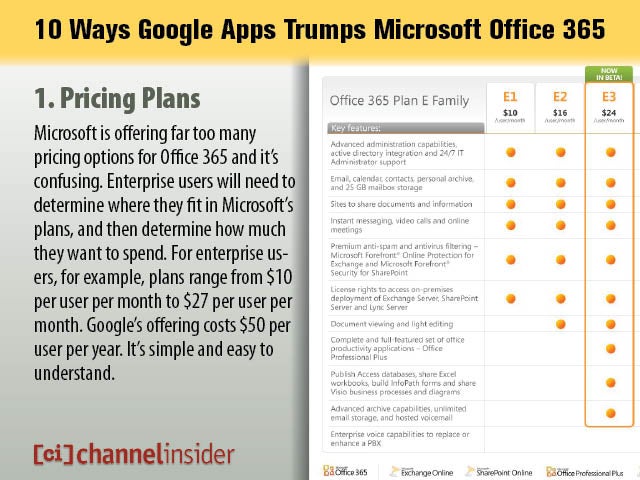 10 Ways Google Apps Trump Microsoft Office 365
10 Ways Google Apps Trump Microsoft Office 365
1. Pricing PlansMicrosoft is offering far too many pricing options for Office 365 and it’s confusing. Enterprise users will need to determine where they fit in Microsoft’s plans, and then determine how much they want to spend. For enterprise users, for example, plans range from $10 per user per month to $27 per user per month. Google’s offering costs $50 per user per year. It’s simple and easy to understand.
 No Title
No Title
2. SimplicityIn all Google products, simplicity means everything. The company’s Google Apps platform is easy to use, simple for employees to understand at first glimpse, and offers a range of solutions that make an employee’s life just a little easier. Simplicity reigns supreme in Google Apps, but in Office 365, given all the options available, expect a learning curve. That’s an issue.
 No Title
No Title
3. The Solution For the Small Business?Though Office 365 might prove to be a better solution for large enterprises that need the advanced functionality found in Microsoft’s solution, Google Apps seems ideally suited for small businesses that don’t need high-end functionality. As Google would readily admit, it can’t necessarily match Office 365 on power and functionality (look at Excel and Google Spreadsheet side by side for proof of that), but when it comes to simple word processing, solid e-mail, good collaboration, and a nice calendar feature, small businesses will find a lot to like in Google Apps.
 No Title
No Title
4. CostAs noted in a previous slide, Office 365 features a slew of pricing plans that charge companies per-user, per-month. Google, on the other hand, charges firms $50 per user per year or $5 per user per month for those who want more flexibility. Over the course of 12 months, Google’s solution should be far less costly than Microsoft’s. And in a world where tight budgets reign supreme, that’s an important factor.
 No Title
No Title
5. It Has Office IntegrationMake no mistake that Google Apps can support Office documents. If users want to edit Word or Excel document in Google Docs, they can do so. And if they want to export those files to Office-friendly extensions, they can. If users don’t need Excel’s power, but still want Office functionality, Google Apps isn’t a bad choice.
 No Title
No Title
6. Calendar Works WellThere’s no telling how Office 365 will work as a scheduling solution until the service launches. But those who have used Google Apps know now that the company’s Calendar app is stellar. It’s easily modifiable, it syncs across many different services, and it doesn’t have a big learning curve for employees to overcome. It’ll be hard for Microsoft to match Google’s Calendar app.
 No Title
No Title
7. Collaboration Works WellOne of the nice things about Google Apps is that it features solid collaboration tools across the board. While employees are using Google Docs, for example, they can work together to edit documents, annotate, and perform other collaborative actions. Moreover, Google Sites allows for a workspace where users can share ideas with each other. Microsoft Sharepoint, while perfect for larger companies, is not so well-matched for smaller companies that need simpler solutions.
 No Title
No Title
8. Google’s Cloud ReputationOne of the issues standing in Microsoft’s way with Office 365 is Google’s reputation in the cloud. The company has made a name for itself by offering Web services that work as advertised and deliver to users a satisfying experience. Microsoft, on the other hand, has yet to prove if it can be a similarly successful cloud provider. Yes, Azure is nice, but will Office 365 fulfill Microsoft’s promises? Time will tell.
 No Title
No Title
9. Google Cloud ConnectOne of the nice things about Google’s cloud services is that it allows for integration into Office. When companies use Google Cloud Connect, they can make changes to an Office document in Microsoft’s program offline, which are then automatically synced to the Google cloud. Even better, multiple people can make changes to a file, and all the revisions are intelligently synced so there’s no overlap. All prior revisions are all made available in the cloud. In essence, the feature allows companies to maintain the same services they have now, but take advantage of Google’s cloud.
 No Title
No Title
10. ExpectationOne of Google’s biggest advantages in the productivity-solutions space is the expectation IT decision-makers have for its service. Just about everyone expects Office 365 to be a solid, well-rounded service. However, expectations are low with Google Apps. And when people start using it, they realize that Google is serious about taking Microsoft on. By achieving greater heights than expected, Google Apps puts pressure on Microsoft to deliver the same “wow” moment to IT decision-makers. And that might not be as easy as some think.

